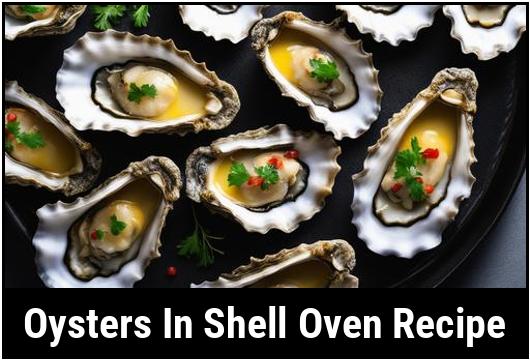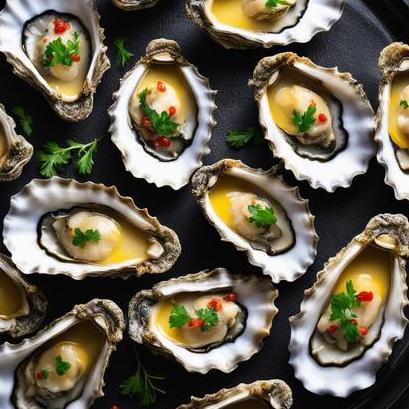
Oysters In Shell Oven Recipe: A Gastronomic Delight
Are you ready to embark on a culinary adventure filled with the delectable flavors of the sea? Look no further than the tantalizing world of oysters! Oysters are a true delicacy, revered by seafood lovers around the globe. In this comprehensive guide, we will explore the art of preparing oysters in a shell oven. From the selection and cleaning process to elegant presentations and mouthwatering variations, we’ll cover every aspect of this gastronomic delight.
Unveiling the Remarkable Food Science Behind Oysters
Before we delve into the culinary details, let’s take a moment to appreciate the fascinating food science behind oysters. Oysters are bivalve mollusks that thrive in brackish or salty waters. They play a vital role in maintaining the ecological balance of our oceans and estuaries. Oysters are filter-feeders, meaning they help clean and purify the waters they inhabit. This unique role in the ecosystem translates into a remarkable depth of flavor when we savor these succulent creatures.
Oysters are prized for their umami flavor profile, which combines savory, salty, and slightly sweet notes. They are also an exceptional source of essential nutrients such as zinc, iron, and vitamin B12. Not only are oysters delicious, but they also offer excellent nutritional benefits.
Selecting the Finest Oysters for Your Culinary Adventure
When it comes to oysters, freshness is paramount. The taste of an oyster can vary depending on its origin and the species. There are several types of oysters, including Eastern oysters (Crassostrea virginica) and Pacific oysters (Crassostrea gigas), each with its own unique flavor profile. It’s essential to select oysters that are alive and with tightly closed shells as an indication of freshness.
Visit your local seafood market or trusted supplier to find the freshest oysters available. Engage with knowledgeable salespersons who can guide you in selecting the best varieties for your recipe. Remember, the success of your oyster dish will depend on the quality and freshness of the oysters you choose.
Cleaning the Oysters: A Prerequisite for Culinary Pleasure

Before you begin preparing your oysters, it is crucial to clean them thoroughly to ensure food safety and enhance their natural flavors. The process is relatively simple and requires only a few steps.
-
Start by scrubbing the shells of the oysters under cold running water to remove any dirt or debris.
-
Use a stiff brush to gently scrub off any stubborn barnacles or algae that may be attached to the shells. Ensure you handle the oysters carefully to prevent injury.
-
Once the shells are clean, inspect each oyster and discard any with damaged shells or that are open and do not close when tapped. These may be indications of spoilage or dead oysters.
-
Rinse the oysters one final time to remove any loose particles or sand.
By taking the time to clean your oysters thoroughly, you will eliminate any potential grittiness and enjoy an unadulterated, pure oyster taste.
Preparing the Oysters: Unlocking the Flavors Within

Now that your oysters are clean and ready, it’s time to unlock their mesmerizing flavors through proper preparation. The shell oven method is an exemplary technique to bring out the unique essence of oysters.
-
Preheat the oven to 450°F (230°C) and adjust the rack to the middle position.
-
Place the cleaned oysters on a baking sheet or in a shallow oven-safe dish, ensuring they are level and stable.
-
Gently pry open the shells slightly, taking care not to spill the precious oyster liquor.
-
Optionally, you may place a small dollop of compound butter, seasoned breadcrumbs, or a drizzle of flavorful sauce on top of each oyster for added richness and complexity.
-
Once all the oysters are prepared to your liking, carefully transfer the baking sheet or dish into the preheated oven.
Mastering the Art of Cooking Oysters: Tips and Variations
Cooking oysters in a shell oven requires precision and careful attention to detail. The goal is to achieve the perfect balance between enhancing their flavors and retaining their inherent tenderness. Here are a few tips to help you achieve oyster perfection:
Doneness Checks:
Oysters cook quickly, and their texture can change rapidly, so it’s essential to keep a close eye on them. Check for doneness by observing the following indicators:
-
The edges of the oysters will begin to curl slightly, along with a gentle bubbling of the liquid inside the shells.
-
The oysters will be plump and opaque, with their flesh slightly firm to the touch, but not rubbery.
Overcooking Pitfalls:
Overcooking can result in tough, chewy oysters, robbing them of their delicate texture and subtle flavors. Avoid overcooking by:
-
Setting a timer and following the recommended cooking times closely. A general guideline is 8-10 minutes for medium-sized oysters.
-
Regularly checking the oysters during the cooking process to prevent any mishaps in the oven.
Avoiding the Peril of Undercooking:
Undercooked oysters can be a potential health hazard, so it is essential to ensure they reach a safe internal temperature. Here are a few precautions to consider:
- Cooking the oysters until their edges curl and the flesh becomes opaque, ensuring they have reached a temperature of at least 145°F (63°C).
Embracing Culinary Adventure: Exploring Delicious Variations
Now that you have mastered the basics of preparing oysters in a shell oven, let your culinary creativity flourish. Here are a few variations to tantalize your taste buds:
-
Broiled Oysters: After cooking the oysters, switch to the broil setting for an additional 2-3 minutes to achieve a perfectly golden-brown crust.
-
Asian-inspired Oysters: Brush the oysters with a blend of soy sauce, sesame oil, and minced ginger before cooking. Garnish with chopped scallions and toasted sesame seeds for an Asian twist.
-
Bacon-Wrapped Oysters: Wrap each oyster with a strip of bacon before placing them in the oven. The bacon will infuse the oysters with its smoky goodness, adding an extra layer of complexity.
The Magnificent Journey Culminates: Savoring the Oysters
Congratulations! You have successfully navigated the intricate world of oysters in shell oven recipes. It’s time to sit back, relax, and indulge in the fruits of your labor.
Serve the oysters hot, straight from the oven, to fully experience their exquisite flavors and aromas. Accompany them with a squeeze of lemon, a dash of hot sauce, or your favorite dipping sauce.
Admire the beautiful presentation of the oysters nestled inside their shells, and take a moment to appreciate the depth of flavor you have unlocked through your culinary prowess. Whether enjoyed as an appetizer, a centerpiece for a lavish seafood platter, or an elegant addition to your next dinner party, these oysters are sure to be a hit among your guests.
Remember, oysters are meant to be savored slowly, allowing the complex flavors to dance on your palate. Each bite is a celebration of the sea and a testament to your culinary expertise.
So, gather your ingredients, don your apron, and let the enchanting world of oysters transport you to a land of gastronomic bliss. Bon appétit!
Sources
FAQS On Oysters In Shell Oven Recipe
What Is An Oysters In Shell Oven Recipe?
An oysters in shell oven recipe is a cooking method that involves baking fresh oysters in their shells. It is a popular and delicious way to prepare oysters, as the oven helps to cook the oysters gently and enhance their natural flavors.
What Ingredients Are Needed For An Oysters In Shell Oven Recipe?
The main ingredient for this recipe is fresh oysters in their shells. Additionally, you will need butter, garlic cloves (minced), lemon juice, parsley (chopped), salt, and pepper. These ingredients are used to create a simple and flavorful mixture that is spread onto the oysters before they are baked.
How Do I Prepare The Oysters For Baking?
To prepare the oysters, start by scrubbing the shells thoroughly under running water to remove any dirt or debris. Next, carefully shuck the oysters using an oyster knife, being cautious to keep the oyster liquor (the natural juices) inside the shells. Once shucked, detach the oyster meat from the shell and place it back inside the shell, discarding any broken pieces or debris.
What Is The Cooking Process For Oysters In Shell Oven Recipe?
To cook the oysters, preheat your oven to a medium-high temperature, usually around 425°F (220°C). In the meantime, prepare the mixture of melted butter, minced garlic, lemon juice, chopped parsley, salt, and pepper. Once the oven is preheated, spread the mixture evenly over each oyster, ensuring that they are generously coated. Place the oysters on a baking sheet or a baking dish and bake for about 10-12 minutes, or until the oysters are cooked and the mixture is bubbly and lightly browned.
How Do I Serve Oysters In Shell Oven Recipe?
Once the oysters are baked to perfection, carefully remove them from the oven using heat-resistant gloves or oven mitts. Serve the oysters immediately, either individually on a platter or in the shells on a bed of rock salt or crushed ice for an elegant presentation. Provide lemon wedges on the side for an extra zesty kick, and enjoy the oysters while they are still warm.



